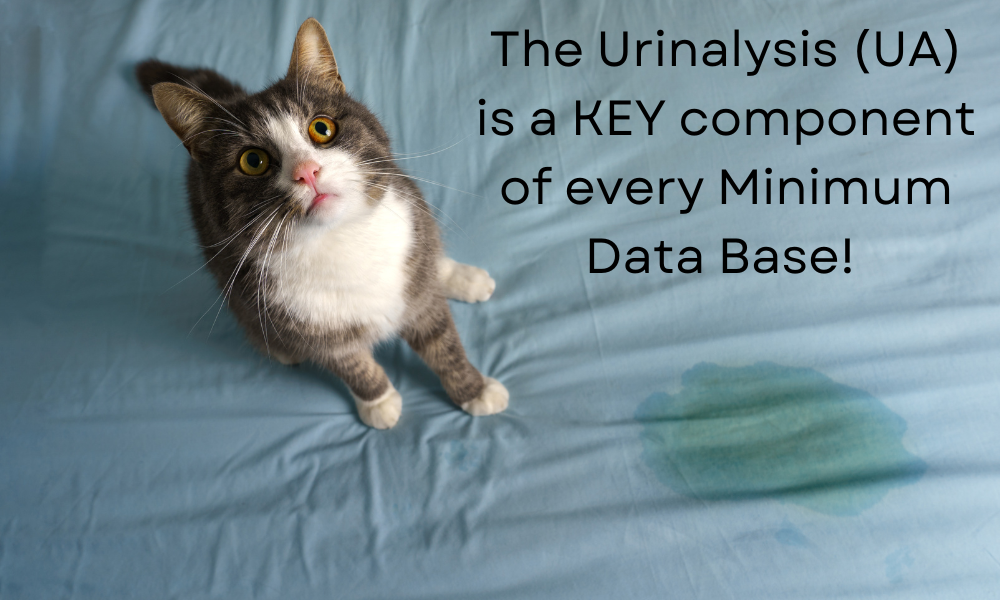Why and when would I recommend blood tests for your cat?
As a veterinarian (specifically a feline-focused veterinarian), my entire professional career is devoted to your cat’s health. There are many ways that we can assess the status of the health of your cat. It starts with the history that you provide. The more details, the better!
Next, a complete physical exam is one of the most important aspects of evaluating your cat. After the exam, our next step includes what we call “diagnostic tests.” This can mean many things…For example, both laboratory tests and imaging (x-rays and/or ultrasound) fall into this category.
Laboratory tests may be called cat blood work, cat blood tests (or feline blood tests), lab work, lab tests or even just “labs.” I’ve heard some people say “bloods” but I’ve never been into that phrase.

Cat blood tests may be performed in the clinic (i.e. “in-house laboratory”) for immediate results or submitted to a large, reference laboratory (more “bang for your buck” but results may not be available until the next day, or longer).
A quick note about normal ranges, aka “reference ranges.” Normal ranges are developed by testing many healthy animals and then formulating a bell curve. Remember, a bell curve is just that.
Most cats will be in the curve but a few cats will be at either end of the curve. So, knowing a cat’s trends over time can be very important when determining what is normal for them.
In addition, there are some values that may be within the reference range but we, as veterinarians, know that the levels are actually not normal. On the opposite end, some tests may be high “on paper” but we really don’t care about them!
So you really have to work together with your veterinarian to understand exactly what’s important and what’s not.

What cats are candidates for blood work? (spoiler alert: all of them!)
Senior or geriatric cats – OK, that’s the obvious one. While age is not a disease, with age comes disease. For all of my older cats, I want to know about their kidney health, their thyroid status and their liver function, to name a few categories. Why? Early detection of problems leads to earlier treatment which generally provides a better prognosis.
Cats on long-term medications, such as thyroid medication, anti-inflammatory medications or chemotherapy drugs, may need blood work on a regular basis to make sure that no blood-related side effects are occurring.
Sick cats are also obvious candidates for blood work. When we perform feline blood tests on sick cats, our goal is to determine the cause of their illness. Sometimes the labs give us the answer. Sometimes they just “rule out” various conditions. For example, your cat’s kidney function looks good on paper. Great! She’s not in kidney failure! Her blood glucose is totally normal. Great! She’s not diabetic!
Healthy adult cats – Really? If she’s healthy, why does my cat need blood tests? For baseline screening purposes, that’s why! We want to know what’s normal for her so that we have something to compare to when one day (and there likely will be a “one day”) she’s sick and needs various laboratory tests performed.
For example, some cats may have a specific white blood cell that runs just a tad low. That’s good to know ahead of time so that I’m not worried when it’s a tad low but normal for her when she’s sick.
I recommend screening blood work on cats without overt signs of illness on a regular basis. In turn, I discover important information!
Kittens? For me, yes. I like to have at least a small blood panel on kittens that are about to undergo their spay or neuter surgery. I want to make sure that they don’t have any hidden problems that were not detected on my physical exam.
Yep, I’ve found kidney disease in young cats before who were otherwise apparently healthy. This allowed us to be proactive and know as much as possible about their health.
Pre-surgical tests may or may not be required by your veterinarian. For me, they are not optional. Everyone has their own opinion on the usefulness of these tests.
Let’s discuss all the routine blood tests that I might recommend for your cat.
I’m going to list abbreviations for these tests in parentheses.

Oh, by the way, obtaining a blood sample on your cat does not need to be a stressful event. Visit a feline-friendly veterinary practice. These Cat Friendly Practices specialize in low-stress handling techniques. In my practice, we have soft music playing in the exam room. We also use thick bath towels for the cats to lay on during their blood draw, all the while offering them a tasty treat for distraction.
Complete Blood Count (aka the CBC)
The CBC examines the white blood cells (WBC aka white cell count), red blood cells (RBC aka red cell count) and platelets (PLT). The white blood cells are classified according to the actual specific type of cells (neutrophils, lymphocytes, monocytes, eosinophils and basophils).
Elevations (or decreases) in certain cell types may clue us in on acute or chronic inflammation, infection, allergies or even parasites.
The red blood cells may be elevated if a cat is dehydrated. Low red blood cells are seen with anemia, which can be further classified based on whether the body is trying to respond to the anemia or not (called regenerative or non-regenerative).
Platelets are the cells that are involved in clotting. High platelets are not common but may be seen with bone marrow disease. Low platelet counts are VERY common in cats and are often easily explained by the fact that cats have platelets that like to clump together, FALSELY decreasing their results. Visibly examining the blood under the microscope can verify that clumps are the reason for the low platelet count.
- *Fun Fact* The white blood cell numbers are listed in two different ways. The “absolute” value is just that. A real number. The “percentage” is the portion of 100% that the specific cell represents. I ONLY CARE ABOUT THE ABSOLUTE VALUES, NOT THE PERCENTS. I pretty much ignore the percentages because it’s the absolute values that give us real info!
Organ Function Screen (aka Chemistry Panel or Chem Panel)
There are various sizes of Chemistry Panels and what we choose depends on what we are looking for. Do I (personally) need every single routine chemistry test that is available for a healthy 6-month-old kitten undergoing a neuter? No. Just a few quick tests are OK with me.
Now, do I want every single routine chemistry test that is available for a 15-year-old cat who is losing weight? Yep. Bring it on. Let’s rule in or rule out some diseases here.
What does the Chemistry Panel test for? All kinds of cat diseases!
The Chemistry Panel analyzes kidney function by examining the creatinine (Cr) and blood urea nitrogen (BUN). However, we must pair these findings with the results of a Urinalysis to accurately assess the kidneys.
If your cat is in kidney failure, we will be able to determine this from the blood work.
Kidney failure is a scary term. I use it if a cat is actually very symptomatic (i.e. sick). Otherwise, I prefer to say “kidney disease.” The word “renal” means kidney, so you’ll also hear Chronic Renal Disease (i.e. CRD).
The International Renal Interest Society (IRIS) has developed guidelines to help stage CRD. When we know what stage of CRD a cat has, this helps us better understand their overall health and what we need to focus on. A 2-year-old cat with stage II CRD (i.e. That’s not good and we need to investigate more!) is a much different situation than a 15-year-old cat with stage II CRD (Great! Your cat only has stage II!).
- *Fun Fact* It takes 75% of loss of kidney function before the blood urea nitrogen and creatinine start to increase on paper. Wow. So a cat may have kidney disease but her lab tests are still normal. See more about kidney disease in the Urinalysis section below.
Liver Disease – The Chemistry Panel can assess the general health of the liver via various liver enzymes such as alanine aminotransferase (ALT), alkaline phosphatase (ALP) and aspartate aminotransferase (AST). Other tests that can be related to the liver and/or gallbladder are Total Bilirubin (T Bil), gamma-glutamyl transferase, (GGT), total protein / serum protein (TP) and glucose (Gluc or BG for blood glucose; we also say “Blood Sugar”).
The total protein (TP) or serum protein is comprised of the proteins albumin (ALB) and Globulin (GLOB). The total protein levels (specifically albumin) can clue us in as to the hydration status of the cat.
Albumin levels can be high or low, indicating dehydration or protein loss (in the kidneys or GI tract, for example). Globulins are often elevated with inflammation of many causes. We can then take the two values and formulate an albumin-to-globulin ratio, called A:G. This ratio helps us in certain cat diseases such as Feline Infectious Peritonitis (FIP).
Diabetes (aka Diabetes Mellitus) is another common disease that we can assess with cat blood tests. Specifically, we look at the blood glucose level and whether or not there is glucose in the Urinalysis.
Cats can easily have an elevated Blood Glucose from stress so we must interpret these results with a keen eye. Sometimes we add on a test called a Fructosamine that can help differentiate stress hyperglycemia from a true elevation.

Other values on the Chemistry Panel
Electrolytes
The electrolytes are sodium (Na), potassium (K) and Chloride (Cl). The electrolyte status is important for assessing hydration and other medical conditions. Electrolyte imbalances may be seen in health conditions such as dehydration and even diseases of the adrenal glands.
Thyroid Levels (Thyroid Hormone Testing)
The main thyroid blood test in cats is called the Total T4, which stands for thyroxine. Thyroid hormone levels are routinely tested in our senior cats. A normal cat should have a thyroid level in the middle of the reference range.
There are other thyroid tests that can be performed when the T4 test results are not straightforward. These tests are the “free T4” (Nope, it’s not free. Sorry!) and the TSH (thyroid stimulating hormone).
Remember, cats get HYPERthyroidism (the T4 is too high) whereas dogs get HYPOthyroidism (the T4 is too low). Hypothyroidism in cats does exist, but it’s rare.
By the way, we commonly see elevated liver enzymes secondary to Hyperthyroidism. We recheck these high levels to make sure they are decreasing once the Hyperthyroidism is under treatment.
The Urinalysis aka UA
Oh, this is a big one! We like to call urine “liquid gold” because it gives us great information! There are three parts to the urinalysis.
1. The Biochemical Strip
This is where we assess for things like glucose and ketones (both of which have to do with diabetes) as well as red blood cells in the urine. Note that urine strips are not accurate for white blood cells in cats. There is NO reason to look at the “leukocyte” result from the strip. It’s there, but we ignore it!
2. The Specific Gravity
Remember when I said that we can only assess kidney (renal) function in light of the urinalysis? A cat could have elevated kidney tests that are simply from dehydration (or even from fasting before surgery). So we must pay attention to the urine specific gravity (aka the “usg”), which is the concentration of the urine sample.
A cat with well-functioning kidneys should have good urine concentration greater than 1.035. We call this “greater than ten-thirty-five.”
A decreased urine specific gravity has historically been the first sign of chronic kidney disease on paper. However, it takes 2/3 loss of kidney function for the specific gravity to decrease. That’s a lot!
Recently, a newer test called SDMA has been developed that can detect kidney disease even earlier. Many reference laboratories include this in their standard cat blood panels nowadays.
3. The Microscopic Exam
This involves either a person or machine visibly evaluating the urine under the microscope to look for the presence of blood cells, bacteria and something called casts.
- *Fun Fact* Did you know that Urinary Tract Infections (UTIs) are very UNCOMMON in young cats? It’s true! Young cats are more likely to get sterile inflammation of their bladder, which has many names such as cystitis and feline lower urinary tract disease. It’s our older cats that are more prone to getting true UTIs and requiring antibiotics. Cats with UTIs should also have a Urine Culture and Sensitivity performed to determine exactly what bacteria is present and what the best antibiotic choice is.

A urine sample can be collected a number of ways. We most commonly perform a “cystocentesis” by inserting a sterile needle directly into the bladder via the skin. This can be ultrasound-guided or by using one’s hand to hold the bladder steady.
While this might sound like a dramatic procedure, it’s very common and appears to cause little discomfort for the cat.
A “voided” urine sample (i.e. your cat pees in the carrier on the way to the clinic or into a litter box containing non-absorbant urine collecting granules) can give us certain information (like the specific gravity) but is not good for assessing the presence of bacteria due to it’s non-sterile nature.
CBC + CHEM +UA = MINIMUM DATA BASE.
We often want all three of these tests for the most complete picture of your cats overall health.
Viral testing
I want an updated viral status on every sick patient I see. What “viruses” are we talking about? The cold? Nope. We’re talking about the infectious diseases Feline Immunodeficiency Virus (FIV) and Feline Leukemia Virus (FeLV).
Parasite testing
Since we’re talking cat blood tests, then a Heartworm Antibody Test is often included with the panels that are sent to the lab. This is an important test for cats who are coughing or having any type of lower respiratory issue (i.e. from the lungs, not the nose).
Yes, even indoor cats get Heartworm Disease! Ask your veterinarian about her risk!
Cancer?
People always ask if we can detect cancer in their cat’s blood sample? Yes and no. Certain types of cancer such as Leukemia can be detected on the Complete Blood Cell Count.
Note that this is not the same as the Feline Leukemia Virus as mentioned above in Viral testing.
However, more often than not, cancer is not obvious from cat blood tests. In fact, many cats with cancer have normal blood tests despite signs such as weight loss or chronic vomiting. Additional information via diagnostics, such as imaging, may be indicated.
In Summary
I recommend blood tests for my feline patients every day. I carefully consider the age and health status of the cat before deciding which blood panel to perform. Sometimes I get the exact diagnosis. Sometimes I don’t. But I get useful information either way. I always try to explain the results in clear, client-friendly terms so that everyone is on the same page.
Please note that the above is for informational purposes only and should not constitute medical advice. Develop a relationship with a feline-friendly veterinarian. Get to know them and ask their opinion. There will be a time when blood tests will be recommended for your cat. Ask any and all questions you have so that you understand the results!
















4 Responses
My 17 year old kitty has been diagnosed with wet FIP . She’s relatively healthy otherwise. Is the use of Remdesivir a reasonable choice? Have you ever treated an elderly cat for advanced FIP?
I’m sorry to hear about your kitty. Remdesivir does appear to be effective against FIP (as well as a similar drug). Here’s some info: https://news.vin.com/default.aspx?pid=210&catId=620&Id=11910939
My cat has pancreatitis and sometimes vomits 🤮 in the morning! What can I do?
I’m sorry your kitty was sick! Work with your veterinarian to discuss option. I like a medication called Cerenia for vomiting. Ask your vet about it!